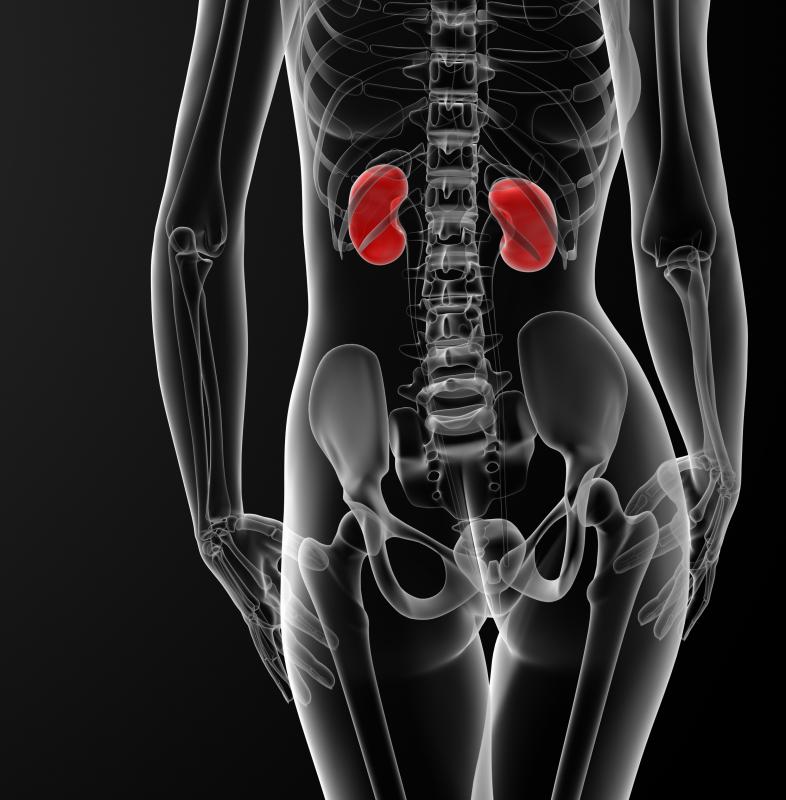At TheHealthBoard, we're committed to delivering accurate, trustworthy information. Our expert-authored content is rigorously fact-checked and sourced from credible authorities. Discover how we uphold the highest standards in providing you with reliable knowledge.
What is the Descending Aorta?
The descending aorta is a branched part of the larger aortic artery, which is the body’s largest passageway for blood. In humans and most animals, the aorta carries blood pumped from the heart to all other parts of the body, usually by pushing that blood through a series of secondary arteries and veins. There are a couple of different key parts to the aorta, and the descending passageways are just one. They typically run away from the heart and down towards the abdomen and legs. This downward motion is what occasions the name “descending.” It is normally divided into two main parts, namely the thoracic and the abdominal, determined largely by location; the thoracic branches occur within the chest, usually somewhat close to the heart, whereas the abdominal connections happen much lower down and help secure blood flow to the various arterial passageways that descend even further into the legs and groin. Most of the time, scholars and researchers think about the descending aortic passageways as a sort of network of branches rather than a single dense artery, and in many respects it is this branched pattern that allows the passageways to be as effective as they are.
Aorta Basics

When it comes to ranking the importance of human organs, the heart is usually at or near the top of the list. Like most complex organs, though, it doesn’t work all on its own. It pumps blood but depends on a network of arteries to actually carry that blood from place to place, and to eventually circulate it back. The aorta is one of the most important of these, and certainly the largest.

When viewed independently, the aorta often has sort of a crooked appearance, sometimes analogized to a candy cane or a traditional shepherd’s staff. At the top, the rounded portion is known as the “aortic arch.” It connects the short side, often called the ascending aorta, with the longer and mostly straight side, known most commonly as the descending aorta. The descending portion is usually further divided into the thoracic and aortic sections, depending on location. Each contains numerous and often complicated branches.
Role of the Thoracic Branches

The thoracic aorta begins at the bottom of the fourth thoracic vertebra, also known as T4. It continues down to T12 and ends in the diaphragm. There are seven arterial branches that stem from the thoracic aorta. Of these seven, four belong to the visceral branch group and three are parietal branches.
The visceral branches include the pericardial, bronchial, esophageal and mediastinal arterial branches. The visceral branches supply oxygenated blood to the outer walls of the heart, the lungs, the esophogus the thymus gland and the lymph nodes.
The parietal branches include the intercostal, subcostal and superior phrenic branches. These supply blood to the intercostal muscles between the ribs, the abdominal muscles and the diaphragm.
Abdominal Aorta

The abdominal descending aorta continues where the thoracic aorta leaves off. It starts at the T12 vertebra of the thoracic spine and ends at L4 — the fourth vertebra in the lumbar spine. The end of the abdominal aorta is also the end of the entire aorta. From there, the aorta branches off into two arteries — the left common iliac artery and the right common iliac artery. These travel down each of the legs to supply blood to the lower limbs.

While the thoracic aorta has seven branches, the abdominal aorta has 11. The 11 branches of the abdominal aorta can be divided into three groups, namely the visceral, parietal, and terminal. These branches supply oxygenated blood to the organs in the abdomen, pelvis and both legs.
Visceral Branches
The visceral branches are celiac, superior mesenteric, inferior mesenteric, middle suprarenals and renals. In addition, males also have the internal spermatic branch, while females have a corresponding ovarian branch. Each of these is connected to the reproductive system and delivers oxygenated blood to the organs there. By contrast, the celiac, superior mesenteric and inferior mesenteric arteries and their branches supply oxygenated blood to the stomach, liver, gall bladder, spleen, pancreas, the intestines, and the appendix. The middle suprarenal and renal arteries supply blood to the kidneys and excretory organs.
Parietal Branches
The parietal branches are the inferior phrenics, lumbars and middle sacral. Of the parietal branches, the inferior phrenic arteries supply blood to the diaphragm. The lumbar arteries supply blood to most of the abdominal muscles. The middle sacral branches supply blood to the sacrum and coccyx area and the rectum. It also connects with the iliac vein.
Terminal Branches
Finally, the terminal branches are called the common iliacs. The common iliac artery branches off to form the external and internal iliac arteries, which supply the legs with oxygenated blood.
AS FEATURED ON:
AS FEATURED ON:















Discuss this Article
Post your comments